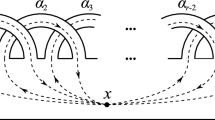Abstract
Let G be a transitive permutation group of degree n with point stabiliser H and let r be a prime divisor of n. We say that G is r-elusive if it does not contain a derangement of order r. The problem of determining the r-elusive primitive groups can be reduced to the almost simple case, and the purpose of this paper is to complete the study of r-elusivity for almost simple classical groups. Building on our earlier work for geometric actions of classical groups, in this paper we handle the remaining non-geometric actions where H is almost simple and irreducible. This requires a completely different approach, using tools from the representation theory of quasisimple groups.
Similar content being viewed by others
References
M. Aschbacher, On the maximal subgroups of the finite classical groups, Inventiones Mathematicae 76 (1984), 469–514.
M. Aschbacher and G. M. Seitz, Involutions in Chevalley groups over fields of even order, Nagoya Mathematical Journal 63 (1976), 1–91.
N. Bourbaki, Lie Groups and Lie Algebras (Chapters 4–6), Elements of Mathematics, Springer, Berlin, 2002.
J. N. Bray, D. F. Holt and C. M. Roney-Dougal, The Maximal Subgroups of the Lowdimensional Finite Classical Groups, London Mathematical Society Lecture Note Series, Vol. 407, Cambridge University Press, Cambridge, 2013.
T. C. Burness, Fixed point spaces in primitive actions of simple algebraic groups, Journal of Algebra 265 (2003), 744–771.
T. C. Burness, Fixed point spaces in actions of classical algebraic groups, Journal of Group Theory 7 (2004), 311–346.
T. C. Burness, Fixed point ratios in actions of finite classical groups, II, Journal of Algebra 309 (2007), 80–138.
T. C. Burness, Fixed point ratios in actions of finite classical groups, IV, Journal of Algebra 314 (2007), 749–788.
T. C. Burness and M. Giudici, Classical Groups, Derangements and Primes, Australian Mathematical Society Lecture Series, Vol. 25, Cambridge University Press, Cambridge, 2016.
T. C. Burness, M. Giudici and R. A. Wilson, Prime order derangements in primitive permutation groups, Journal of Algebra 341 (2011), 158–178.
P. J. Cameron, M. Giudici, G. A Jones, W. M. Kantor, M. H. Klin, D. Marušič and L. A. Nowitz, Transitive permutation groups without semiregular subgroups, Journal of the London Mathematical Society 66 (2002), 325–333.
B. Fein, W. M. Kantor and M. Schacher, Relative Brauer groups II, Journal für die Reine und Angewandte Mathematik 328 (1981), 39–57.
The GAP Group, GAP—Groups, Algorithms and Programming, Version 4.4, 2004.
M. Giudici, Quasiprimitive groups with no fixed point free elements of prime order, Journal of the London Mathematical Society 67 (2003), 73–84.
M. Giudici and S. Kelly, Characterizing a family of elusive permutation groups, Journal of Group Theory 12 (2009), 95–105.
M. Giudici, L. Morgan, P. Potočnik and G. Verret, Elusive groups of automorphisms of digraphs of small valency, European Journal of Combinatorics 46 (2015), 1–9.
D. Gorenstein, R. Lyons and R. Solomon, The Classification of the Finite Simple Groups, Number 3, Mathematical Surveys and Monographs, Vol. 40, American Mathematical Society, Providence, RI, 1998.
R. M. Guralnick and J. Saxl, Generation of finite almost simple groups by conjugates, Journal of Algebra 268 (2003), 519–571.
G. Hiss and G. Malle, Low dimensional representations of quasi-simple groups, LMS Journal of Computation and Mathematics 4 (2001), 22–63.
G. Hiss and G. Malle, Corrigenda: Low dimensional representations of quasi-simple groups, LMS Journal of Computation and Mathematics 5 (2002), 95–126.
J. E. Humphreys, Conjugacy Classes in Semisimple Algebraic Groups, Mathematical Surveys and Monographs, Vol. 43, American Mathematical Society, Providence, RI, 1995.
G. D. James, On the minimal dimensions of irreducible representations of symmetric groups, Mathematical Proceedings of the Cambridge Philosophical Society 94 (1983), 417–424.
C. Jansen, The minimal degrees of faithful representations of the sporadic simple groups and their covering groups, LMS Journal of Computation and Mathematics 8 (2005), 122–144.
W. M. Kantor and Á. Seress, Prime power graphs for groups of Lie type, Journal of Algebra 247 (2002), 370–434.
P. B. Kleidman and M. W. Liebeck, The Subgroup Structure of the Finite Classical Groups, London Mathematical Society Lecture Note Series, Vol. 129, Cambridge University Press, Cambridge, 1990.
A. S. Kleshchev and P. H. Tiep, Small-dimensional projective representations of symmetric and alternating groups, Algebra & Number Theory 6 (2012), 1773–1816.
V. Landazuri and G. M. Seitz, On the minimal degrees of projective representations of the finite Chevalley groups, Journal of Algebra 32 (1974), 418–443.
M. W. Liebeck and G. M. Seitz, Unipotent and nilpotent classes in simple algebraic groups and Lie algebras, Mathematical Surveys and Monographs, Vol. 180, American Mathematical Society, Providence, RI, 2012.
M. W. Liebeck and G. M. Seitz, Reductive subgroups of exceptional algebraic groups, Memoirs of the American Mathematical Society 121 (1996).
M. W. Liebeck and A. Shalev, Simple groups, permutation groups and probability, Journal of the American Mathematical Society 12 (1999), 497–520.
F. Lübeck, Small degree representations of finite Chevalley groups in defining characteristic, LMS Journal of Computation and Mathematics 4 (2001), 135–169.
R. P. Martineau, On 2-modular representations of the Suzuki groups, American Journal of Mathematics 94 (1972), 55–72.
C. E. Praeger, Á, Seress and S. Yalcinkaya, Generation of finite classical groups by pairs of elements with large fixed point spaces, Journal of Algebra 421 (2015), 56–101.
J.-P. Serre, On a theorem of Jordan, Bulletin of the American Mathematical Society 40 (2003), 429–440.
R. Steinberg, Endomorphisms of linear algebraic groups, Memoirs of the American Mathematical Society 80 (1968).
G. E. Wall, On the conjugacy classes in the unitary, symplectic and orthogonal groups, Journal of the Australian Mathematical Society 3 (1963), 1–62.
J. Xu, On elusive permutation groups of square-free degree, Communications in Algebra 37 (2009), 3200–3206.
Author information
Authors and Affiliations
Corresponding author
Rights and permissions
About this article
Cite this article
Burness, T.C., Giudici, M. Locally elusive classical groups. Isr. J. Math. 225, 343–402 (2018). https://doi.org/10.1007/s11856-018-1663-7
Received:
Revised:
Published:
Issue Date:
DOI: https://doi.org/10.1007/s11856-018-1663-7




